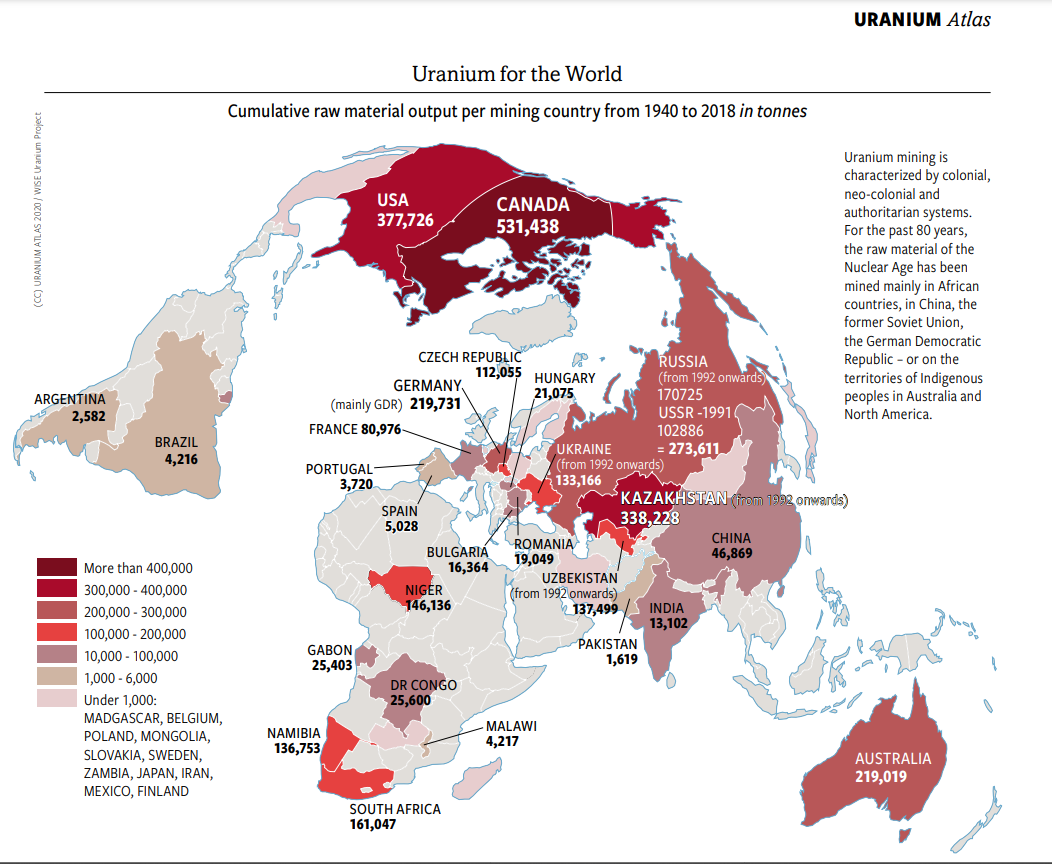Image courtesy of Willis D. Vaughn/National Geographic/Getty Images
Uranium mining is a piece of the nuclear weapons story that is often on the outskirts, if it is mentioned at all. “For the past 80 years, the raw material of the Nuclear Age has been mined mainly in African countries, in China, the former Soviet Union, the German Democratic Republic - or on the territories of Indigenous peoples in Australia and North America.” Uranium Atlas
The uranium that powered the discovery of nuclear fission and its use in the first atomic weapons came from a mine called Shinkolobwe in what is now the Democratic Republic of the Congo. Vastly more concentrated and powerful than any other deposit of uranium found on Earth, the Shinkolobwe ore made possible an apocalyptic effort of engineering that has transformed the way that power works in the modern world.
It is important to note that concentrations of uranium in uranium ore vary dramatically. “Mines in the US and Canada were considered a ‘good’ prospect if they could yield ore with 0.03% uranium. At Shinkolobwe, ores typically yielded 65% uranium. The waste pile of rock deemed too poor quality to bother processing, known as tailings, contained 20% uranium.” - Frank Swain, The forgotten mine that built the atomic bomb
The mine's exploitation has left a legacy of contaminated territories, poisoned communities, and a gross shadow of atomic devastation which echoes through our most popular contemporary stories (such as Black Panther), and clouds our ability to imagine a different world.
We invite you to learn about Shinkolobwe this week through this linocut map-print by artist Roger Peet.
Roger gave a talk as part of our scholar series on Shinkolobwe that you can view here. His talk describes the arc of that history, and displays the linocut map-print which traces the evidence left behind in the landscape by those Congolese rocks; the foundation of the Manhattan Project.
An exhibition about his Shinkolobwe work entitled "Dig Up The Sun" will open at Souvenir Gallery, 1233 NE Alberta Street in Portland, Oregon on October 6th, and runs through the end of the month.
We’ll end this with the first two paragraphs of Winona LaDuke’s preface to Uranium Atlas:
“A creation story of the Diné, an Indigenous Nation in the Southwest of the United States, speaks of two kinds of yellow dust: the first humans were told that the yellow dust of corn pollen would secure their life. The other yellow powder however would endanger it. They were instructed to leave the other yellow powder – uranium – in the soil and never dig it up. If it were taken from the ground, they were told, a great evil would come.
And the evil came. Uranium, traded globally, even has a name reminiscent of this story from the beginning of time. It is called yellowcake. More than three thousand Diné, who are also called Navajo, worked in the uranium mines in the 1950s, without special work clothes or any kind of radiation protection. Covered in radioactive dust, they walked home to their families – and without knowing it, contaminated their loved ones. People are still dying in Dinétah, the land of the Navajo. The danger is not contained, since almost a thousand abandoned mines still contaminate the region.” - Winona LaDuke Uranium Atlas
Here are a few resources to learn more. Let us know if you have any favorite resources and we can add them:
The Wound at the Heart of the World by Roger Peet (presentation) and Roger’s (art)
Uranium Atlas Facts and Data about the Raw Material of the Atomic Age, a collaboration between Nuclear Free Future Foundation, Rosa Luxemburg Stiftung, Beyond Nuclear, and International Physicians for the Prevention of Nuclear War (booklet and download) You can contact Beyond Nuclear for a hard copy
Beyond Nuclear: Africans and the Global Uranium Trade by Gabrielle Hecht (book)
The Highway of the Atom by Peter Van Wyck, Canadian uranium mining (book)
Healing Hózhó in the Nukescape: Hózhó Naasháa Doo by Mahal Miles and Linda Marie Richards (article)
The Forgotten Mine that Built the Atomic Bomb by Frank Swain (article)
First They Mined for the Atomic Bomb. Now They’re Mining for E.V.s. by Roger Peet, The New Republic, Aug 30, 2023 (article)
Church Rock, America’s forgotten nuclear disaster, is still poisoning Navajo lands 40 years later by Samuel Gilbert (article)
‘A deadly, toxic slime’: Spokane Tribe battles environmental fallout of shuttered uranium mine, King 5 News (video and article)
Invisible Devastation: The Global Legacy of Uranium, Physicians for Social Responsibility, guest speakers: Shampa Biswas, Alicia Inez Guzmán, Arieann Harrison, Makoma Lekalakala, and Mitchie Takeuchi (presentation)
Yellow Dirt: A Poisoned Land and the Betrayal of the Navajos by Judy Pasternak (book)
Leave Uranium in the Ground, Global Launch of the Uranium Atlas by Rosa Luxemburg Stiftung (video)
The Church Rock Uranium Mill Spill (Church Rock, New Mexico, in the Navajo Native American Reservation) on the Environment and Society Portal website (webpage with list of resources)
Spies in the Congo: America’s Atomic Mission in World War II by Susan Williams (book)
Church Rock, America’s forgotten nuclear disaster, is still poisoning Navajo lands 40 years later by Samuel Gilbert (article)
Midnite Uranium Mine, Spokane Riverkeeper (webpage)
Uranium Mining, Atomic Heritage Foundation (article)
The reopening of an uranium mine in Arizona has Indigenous people worried, by Michel Marizco, NPR Story (audio and transcript)
In Congo, silence surrounds forgotten mine that fueled first atom bombs, by Tom Zoellner, Aljazeera America (article)
Uranium mines harm Indigenous people – so why have we approved a new one?, by Jessica Urwin, The Conversation, Western Australian uranium mining (article)
Cameco Corp still set on WA uranium mine, despite government knockback, Indigenous opposition, by Sean Tarek Goodwin, ABC Goldfields, Western Australian uranium mining (article)
Australia: Indigenous communities must take centre stage in 'development' by Seán Kerins (article)



